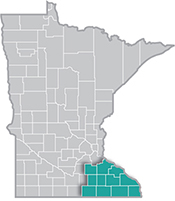After the pandemic recession shook up the labor market last year, Southeast Minnesota has settled back into a tight labor market. Employers are looking for workers and often are struggling to find them for a variety of reasons. It is more than an issue of simple supply and demand.
The most recent updates to DEED's Job Vacancy Survey data for the fourth quarter of 2020, along with data from DEED's Local Area Unemployment Statistics data, shows that the jobseeker per vacancy ratio in Southeast rests at 1.1-to-1 – with 9,933 unemployed workers for 8,917 job postings. This ratio is higher than the pre-pandemic count (fourth quarter of 2019) of 0.7-to-1, however is much lower than what was seen during the height of the pandemic (2nd quarter of 2020) where the ratio sat at 2.3-to-1, and dramatically lower than that during the Great Recession, when there were 5.8 workers for every job vacancy (see Figure 1).

While unemployment rates in the region are higher than in the past couple years, they are much lower than during the Great Recession, and the actual count of unemployed workers is up only 2,300 compared to the fourth quarter of 2019 – showing a return to a tight labor market.
Here are some additional interesting facts about the 4th quarter 2020 Job Vacancy Survey results for Southeast Minnesota:
- The 8,917 job vacancies make the region 5th lowest in vacancies of the six planning regions, equaling 7% of the total vacancies in the state.
- Just over one-third (34%) of the vacancies were part-time, which is the second lowest it has been in the last decade, while only 12% were temporary or seasonal. This shows that employers are looking for full-time workers to meet demand and are not overly concerned about long-term labor commitments.
- Slightly less than one-third of postings (32%) required post-secondary education, which was slightly lower than the 34% average during the last 10 years, showing that there are very few barriers to entry for workers and that employers are adjusting requirements to widen their applicant pools.
- 46% required one or more years of experience, which is the 3rd highest percentage seen in the last decade, demonstrating a renewed emphasis on work skills over formal training.
- Half required a certificate or license, which was the highest percentage the region has seen in the last 10 years, highlighting the importance of specific training as needed.
- 65% offered a health insurance benefit, which was the third highest percentage seen in the last 10 years. This may be, at least partially, due to more companies offering health insurance or other benefits as a perk to attract applicants.
Southeast Minnesota is well known for its high concentration of employment in Health Care & Social Assistance, as well as Manufacturing. Though these industries suffered slowdowns during the early part of the pandemic recession, they are back to more typical hiring patterns now. The region saw a much more noticeable dip in hiring demand in Retail Trade and Accommodation & Food Services, which were greatly impacted by the pandemic. Other interesting details include:
- The highest number of vacancies were for Healthcare Practitioners and Technical occupations (1,428 openings) and Food Preparation and Serving Related occupations (1,409 openings), which together accounted for just under one-third (31.8%) of the total regional vacancies.
- Over half (58%) of the total vacancies are accounted for by the top five occupational groups – Healthcare Practitioners and Technical, Food Preparation and Serving Related, Healthcare Support, Sales and Related, and Production. If job seekers want jobs, they are available here!
- The lowest number of vacancies were seen among Life, Physical and Social Science, Farming, Fishing and Forestry, Protective Service, and Arts, Design, Entertainment, Sports and Media occupations, each of which had fewer than 90 vacancies.
- The median wage offer across all openings sat at $16.49 per hour, which was 9% higher than the fourth quarter wage offer in 2019, and 32.4% higher than that seen 10 years ago.
- However, this median wage offer was still slightly lower than the amount that each adult in the typical Minnesota family (two adults, one working full-time and one working part-time, with one child) would need to earn to meet the basic cost of living needs, which was $16.52 per hour in the fourth quarter of 2020.
- In comparison, a single person with one child would need to earn $22.85 per hour to meet the basic cost of living needs, which is much higher than the fourth quarter median wage offer for the vacancies across all occupations.
For More Information
Contact Mark Schultz.
 Southeast Minnesota is a health care and agricultural powerhouse. The region is home to the renowned Mayo Clinic and some of the world's most recognized food companies and brands.
Southeast Minnesota is a health care and agricultural powerhouse. The region is home to the renowned Mayo Clinic and some of the world's most recognized food companies and brands.